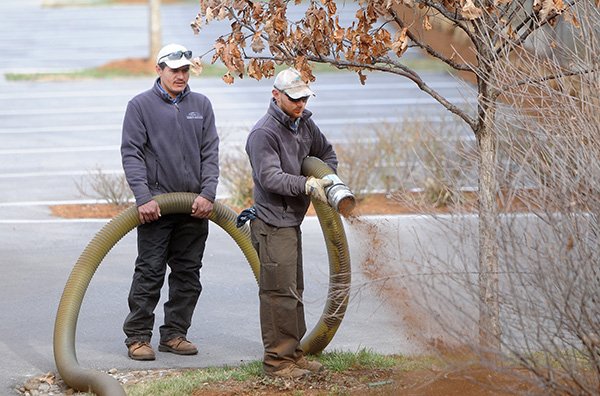After a long, cold winter, some gardeners are starting with a fresh palette this spring, as perennial plants not native to the region did not survive extreme temperatures.
Cody George, horticulturist at Crystal Bridges Museum of American Art in Bentonville, said that because 90 percent of the more than 51,000 plants on the museum's 120 acre site are native plants, they did not sustain much weather-related damage.
GO & DO
Crystal Bridges Museum
Discover the Grounds!
Transient Beauty
What: Cody George, museum horticulturist, and Lori Lincks, museum educator, will discuss transient beauty in art and nature. The talk will include a guided museum trail tour to see native ephemerals.
When: 9-10:30 a.m. April 12
Where: Tulip Tree Shelter at Crystal Bridges Museum
Information: (479) 418-5700 or crystalbridges.org
Botanical Garden of the Ozarks
Composting Made Simple
What: Learn the basics of composting
When: 6 p.m. Thursday
Your Grandmother Grew That: Heirloom Plants for Today’s Gardens
What: Joyce Mendenhall will discuss incorporating heirloom plants in home landscapes.
When: 10 a.m. April 5
Information: 750-2620 or bgozarks.org
"That's the beauty of native gardening. They're adapted to the weather."
Native gardening is the use of flowers, shrubs, trees, grasses and groundcovers that are indigenous to a region. According to the University of Arkansas Division of Agriculture Cooperative Extension Service website, native plants "are adapted to the rainfall, temperatures and soil conditions in Arkansas ... (and) equipped to survive the stresses of drought temperature extremes, floods and plant diseases present in the area."
Native gardening goes beyond the economic impact of having to replace plants that don't weather well. Native plants are part of a bigger ecological picture, George said.
"There's a whole ecosystem dependent on native plants. Bugs, birds, wildlife" need native plants for food, habitat and to be able to pollinate other plants. "With non-native plants, we're offering them a mirage" that does not help them survive, he said.
Lissa Morrison, lead gardener at the Botanical Garden of the Ozarks in Fayetteville, said native gardening is important because as "we've moved into cities and manicured landscapes, we've abandoned plants that feed birds, bees, pollinators, insects -- the critters that make the world work."
She pointed out that last year's monarch butterfly count was the lowest it's been since counts were started 20 years ago.
Morrison emphasized that she's not saying people have to have a "wild and woolly" look to their yards, but incorporating native with non-native plants will be a positive move.
"We need to get the balance back. We can have the beautiful things we love in with the plants that help feed those critters."
For those replacing non-natives this spring, Morrison suggests some of her favorite shrubs and perennials:
• Brandywine -- Viburnum nudum, a deciduous (drops leaves seasonally) low-maintenance shrub, blooms in spring, attracts birds and butterflies, grows 5-12 feet tall;
• Smooth hydrangea -- Hydrangea arborescens, a rounded deciduous shrub, large white flowers bloom through summer, attracts bees, grows 3-5 feet tall.
• Sweetspire -- Itea virginica, a semi-evergreen to evergreen shrub, long white flowers bloom in early summer, attracts butterflies, grows 3-6 feet tall.
• Indian pink -- Spigelia marilandica, a herbaceous (above ground growth dies in winter) perennial wildflower, red and yellow flowers bloom in late spring, attracts hummingbirds, grows 1-3 feet tall.
• Black-eyed Susan -- Rudbeckia fulgida, a herbaceous perennial, yellow flowers bloom from June to late fall, attracts butterflies, grows 2-3 feet tall.
• Purple coneflower -- Echinacia purpurea, a herbaceous perennial, purple flowers bloom from early to late summer, attracts butterflies, grows 2-5 feet.
• Pink muhlygrass -- Muhlenbergia capillaris, a clumping perennial ornamental grass, clouds of airy pink flowers bloom in late summer and fall, attracts beneficial insects and birds.
Though there are many varieties of crape myrtles in Northwest Arkansas, they are not natives, and George said that along with susceptibility to winter extremes, they -- and Japanese boxwoods -- invite Japanese beetles. If gardeners are looking for a decorative tree, he recommended serviceberry.
He said people like crape myrtles because they have multi-season interest. Serviceberry has that and more.
"It's multi-trunked, with early white blooms -- even before dogwoods. In summer they produce fruit that's good in jams and pies, and they provide great fall foliage."
The following are among natives the UA Extension Service recommends for attracting wildlife:
Trees
• American Beech, Fagus grandiflora
• American Elm, Ulmus americana
• Pecan, Carya illinoensis
• Tulip tree, Liriodendron tulipifera
• White oak, Quercus alba
Shrubs
• Black cherry, Prumus serotina
• Eastern redbud
• Box elder, Acer negundo
• Eastern redbud, Cercis canadensis
• Flowering dogwood, Cornus florida
• Sassafras, Sassafras albidum
Vines
• Blackberry, Dewberry, Rubus spp.
• Coral honeysuckle, Lonicera sempervirens
• Cross vine, Bignonia capreolata
• Trumpet vine, Campsis radicans
• Virginia creeper, Parthenocissus quinquefolia
Wildflowers
• Bee balm, Monarda spp.
• Common milkweed, Asclepias syriaca
• Lanceleaf coreopsis, Coreopsis laciniatum
• Rose verbena, Glandularia canadensis
• Tall blazing star, Liatris aspera
NAN Life on 03/26/2014

